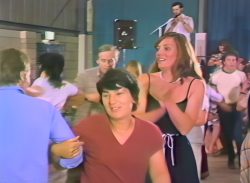 FORTY years ago community activists Sue and John Holman and Trevor Bailey decided to make a video about the North Dorset village of Bourton and its people. In the intervening years the film has been largely forgotten, but now the original tapes have been digitised by Windrose Media Trust, which was founded by Trevor Bailey, and this important piece of social history is once again available to watch.
FORTY years ago community activists Sue and John Holman and Trevor Bailey decided to make a video about the North Dorset village of Bourton and its people. In the intervening years the film has been largely forgotten, but now the original tapes have been digitised by Windrose Media Trust, which was founded by Trevor Bailey, and this important piece of social history is once again available to watch.
Trevor, John and Sue, who had worked together as the Trilith charity for many years on oral history, archive and film projects, were central to efforts to influence the local authority over Bourton’s traffic problems, including a march of protest down the main road which attracted national media attention, and to the successful campaign to get the local pub re-opened after its closure by an unsympathetic brewery.
They wanted to make a record of the community as it was in 1983 and, in the process, help residents old and new to understand a little more about each other’s viewpoints. Rural life had changed massively since the 1960s and would continue to do so. There was much that needed to be expressed. It was rather an amateur effort using borrowed equipment which, although itself semi-professional, was primitive by modern standards. It was made in three parts, together totalling about two hours 20 minutes.
 It took a vast amount of work but it was eventually completed and made available to the community on VHS copies. Part of the aim was to involve the BBC, which made and broadcast a 26-minute documentary about the creation of the Bourton Village Video. Subsequently a small booklet was published, partly to encourage other villages to use the media in a similar way. The upshot was that Bourton had an unusual moment in the public consciousness.
It took a vast amount of work but it was eventually completed and made available to the community on VHS copies. Part of the aim was to involve the BBC, which made and broadcast a 26-minute documentary about the creation of the Bourton Village Video. Subsequently a small booklet was published, partly to encourage other villages to use the media in a similar way. The upshot was that Bourton had an unusual moment in the public consciousness.
The old master tapes of the Bourton film have lain unused for many years. Quite often people who remember the project have asked if the video could be restored and made available again. Now at last that has happened. The original tapes have been digitised by Windrose Rural Media Trust and, although they have developed a few faults over four decades of storage, they have survived remarkably well.
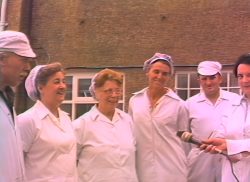 When the film was made, east and west-bound traffic on the A303 all went through the middle of Bourton and the adjoining village of Zeals. The milk factory was in full swing, employing around 70 people. The first new estates, Mill Rise and New Close, had fairly recently been built. The contentious sale of council houses was advanced. The village had two garages and two pubs. June and Trevor Griffin had revived the fortunes of the old shop.
When the film was made, east and west-bound traffic on the A303 all went through the middle of Bourton and the adjoining village of Zeals. The milk factory was in full swing, employing around 70 people. The first new estates, Mill Rise and New Close, had fairly recently been built. The contentious sale of council houses was advanced. The village had two garages and two pubs. June and Trevor Griffin had revived the fortunes of the old shop.
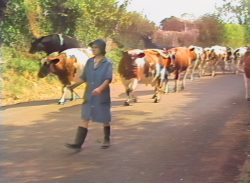 Many people feature in the film – some have died or moved away, others who were children at the time are now middle aged. Memories captured on video stretch back to both world wars. Ken Harcourt remembers disembarking in Bombay docks when in the army, by far the furthest he ever went from the village, and immediately seeing a crane made by the iron foundry, Hindleys of Bourton. “Pop” Suter talk about the introduction of navy blue PE knickers at the school. The whole community’s dear friend, the late Fran Summerfield, is glimpsed in a most uncharacteristic curly hairdo which she got rid of the next week!
Many people feature in the film – some have died or moved away, others who were children at the time are now middle aged. Memories captured on video stretch back to both world wars. Ken Harcourt remembers disembarking in Bombay docks when in the army, by far the furthest he ever went from the village, and immediately seeing a crane made by the iron foundry, Hindleys of Bourton. “Pop” Suter talk about the introduction of navy blue PE knickers at the school. The whole community’s dear friend, the late Fran Summerfield, is glimpsed in a most uncharacteristic curly hairdo which she got rid of the next week!
Local forester Roger Moores appears at the age of about 12, wise beyond his years. His grandfather, Jack, happily bursts into song, remembering an evening at the pub in his youth. Gerald Moores and Danny Lawes, for whom Bourton is their lifelong home, give terse opinions with a strong grain of truth. Farmer Geoff Miller is filmed in the harvest field telling how he thought of leaving for another life at the age of 18 but “that soon passed!”.
Many newer residents were interviewed. Tom Mitchell, then clerk to the parish council, talks about how Bourton can get its needs recognised in the wider world. People who live on the new estates give their perspective. Passers-by, stopping for petrol, are asked to guess about the nature of the village and what goes on there.
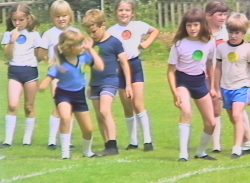 A teenaged Ruth Whitehand and a group of her contemporaries sit on the grass and contemplate the lives before them. The school features strongly, as do the children of the time. The roles of the church and the doctor’s surgery are covered and the then quite new village hall appears, as do many corners of the village as they were in 1983. And there are the advertisements for Bourton businesses.
A teenaged Ruth Whitehand and a group of her contemporaries sit on the grass and contemplate the lives before them. The school features strongly, as do the children of the time. The roles of the church and the doctor’s surgery are covered and the then quite new village hall appears, as do many corners of the village as they were in 1983. And there are the advertisements for Bourton businesses.
In the middle of shooting one of the village’s great disasters happens: the school burns down. That provokes many reflections.mBut at the end of the video the hall is full of Bourton people. The village dances.
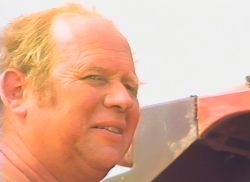 Many thanks are due to James Harrison of Windrose Rural Media Trust and James Harrison Productions who undertook all of the technical work necessary. All three parts of the Bourton Village Video are freely available to view through the Windrose Rural Media Trust website via this link: https://windroseruralmedia.org/2024/08/24/bourton-1983-video
Many thanks are due to James Harrison of Windrose Rural Media Trust and James Harrison Productions who undertook all of the technical work necessary. All three parts of the Bourton Village Video are freely available to view through the Windrose Rural Media Trust website via this link: https://windroseruralmedia.org/2024/08/24/bourton-1983-video
Pictured: Stills from the Bourton Village Video, including farmer (and long-time councillor) Geoff Miller, children at the school sports day, the school on fire, leading cattle back to the farm and “the village dances.”